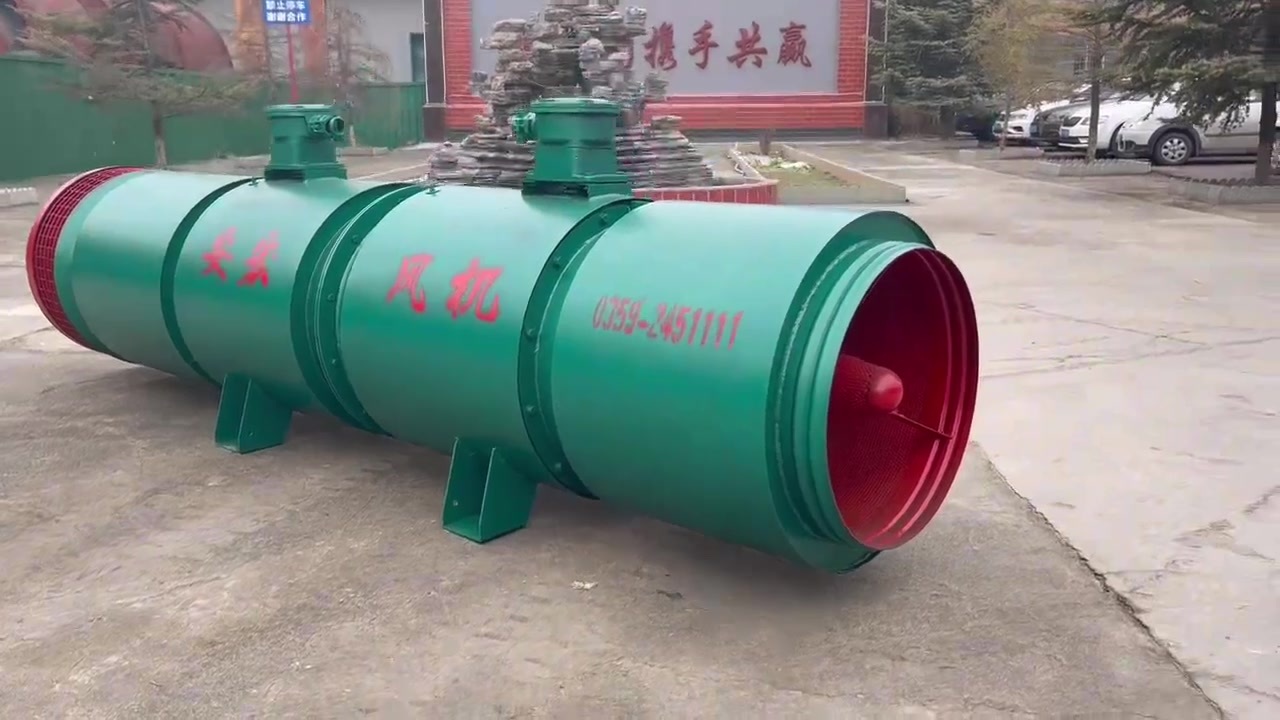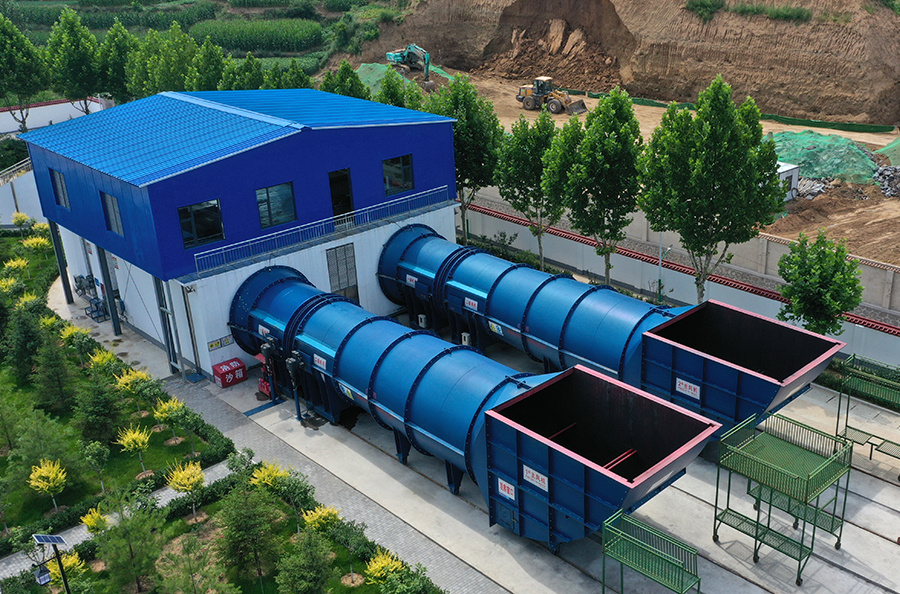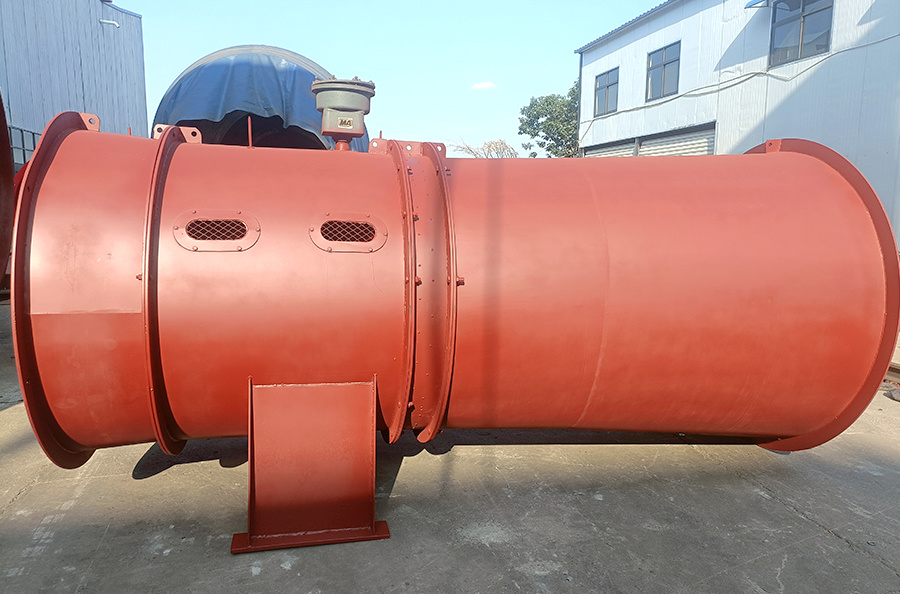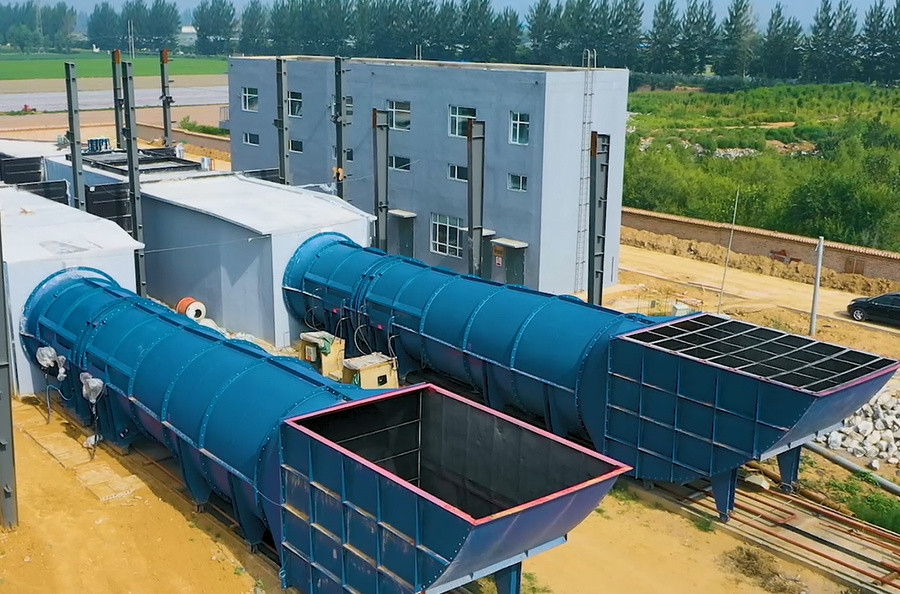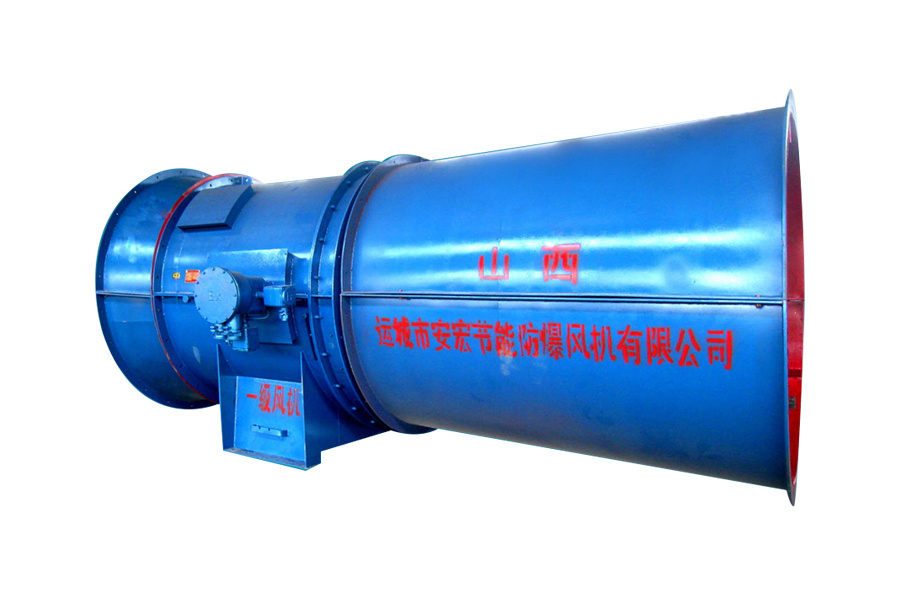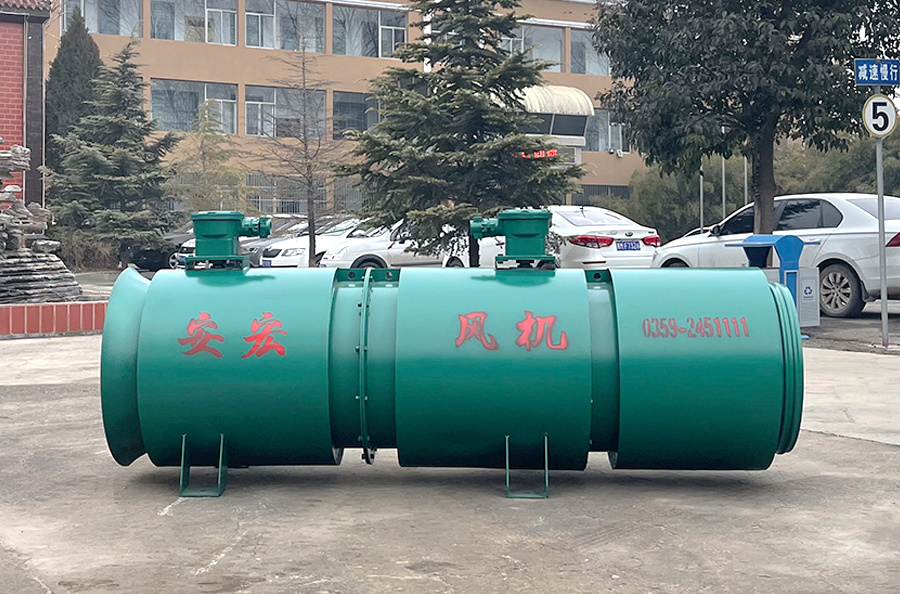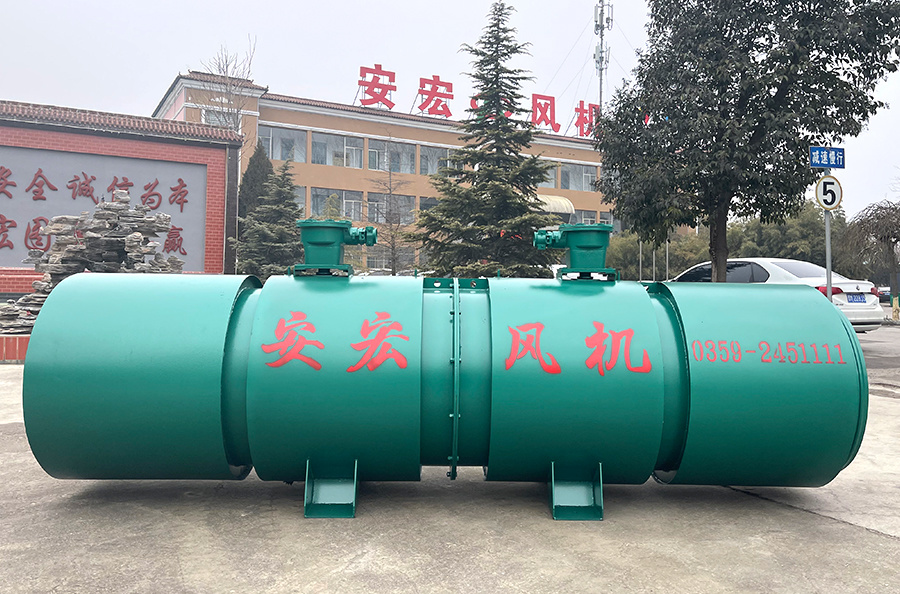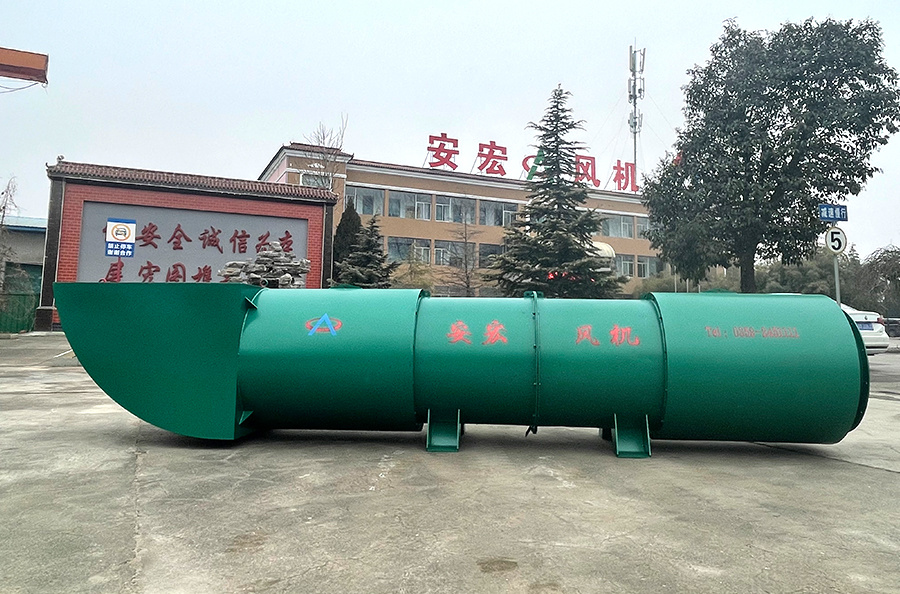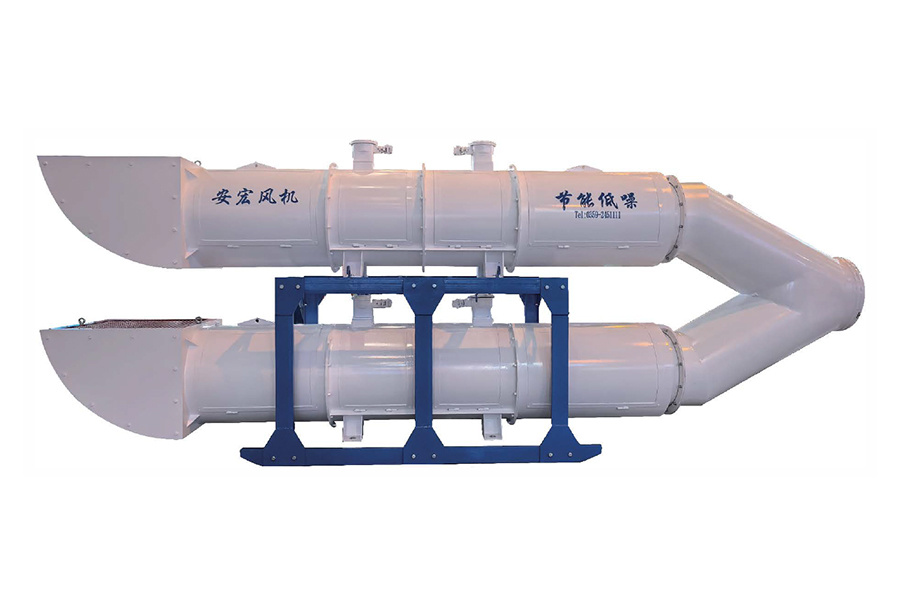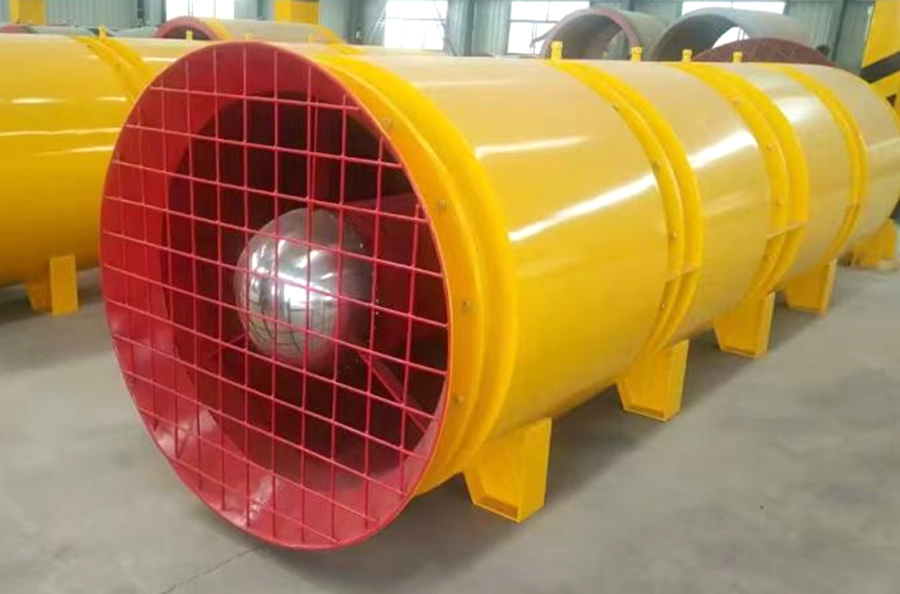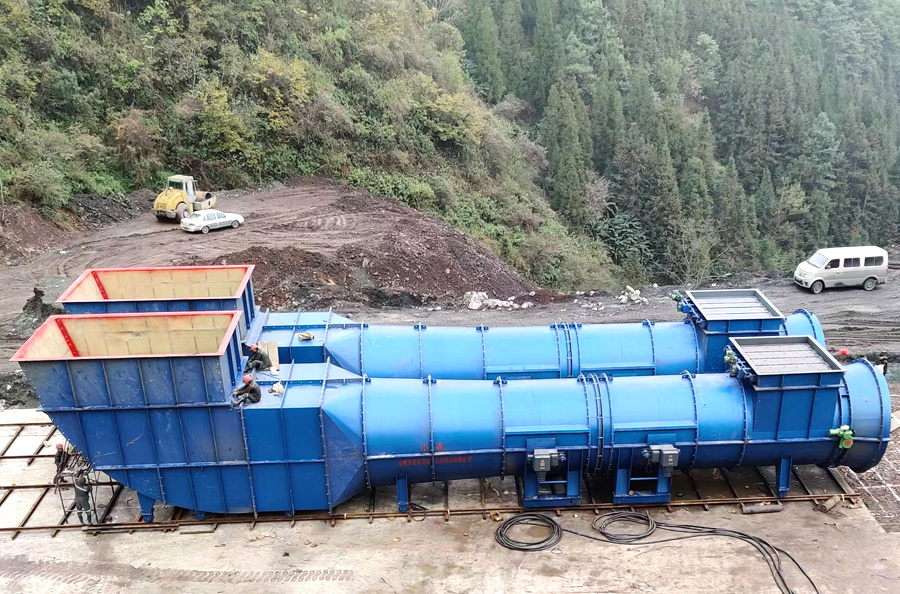
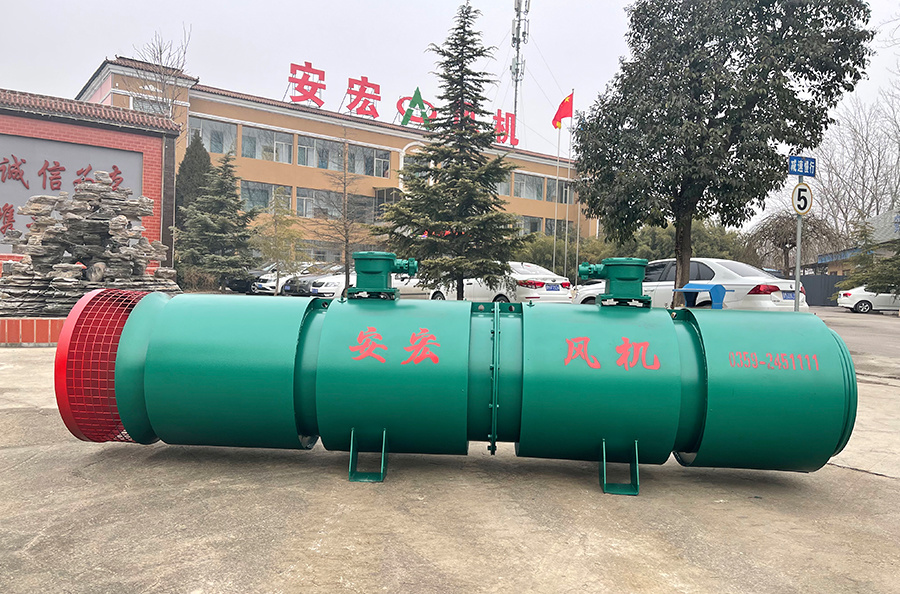
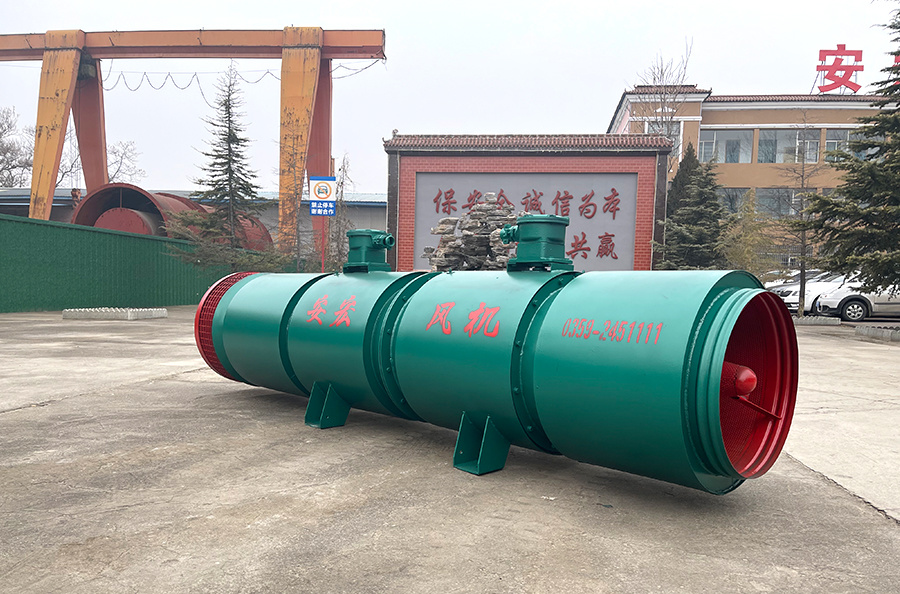
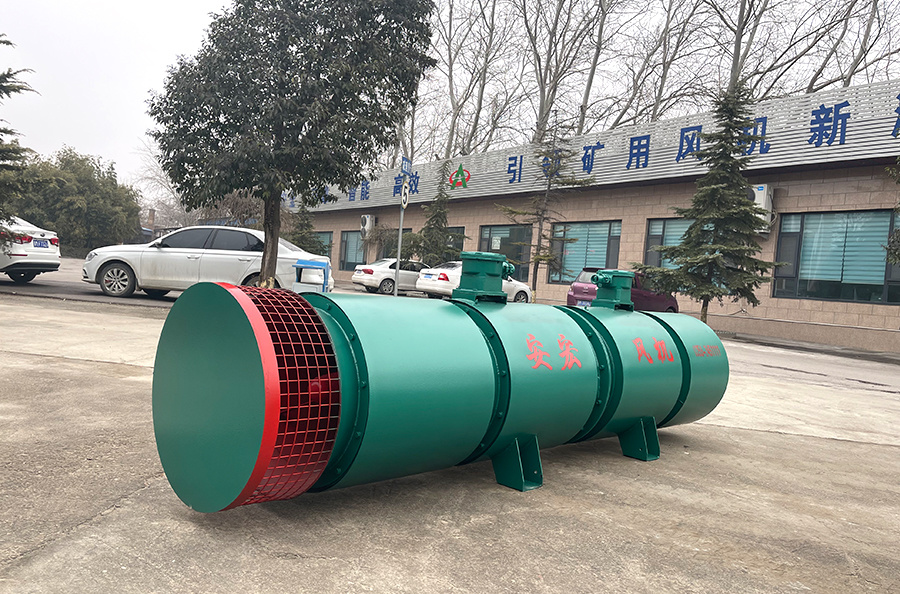
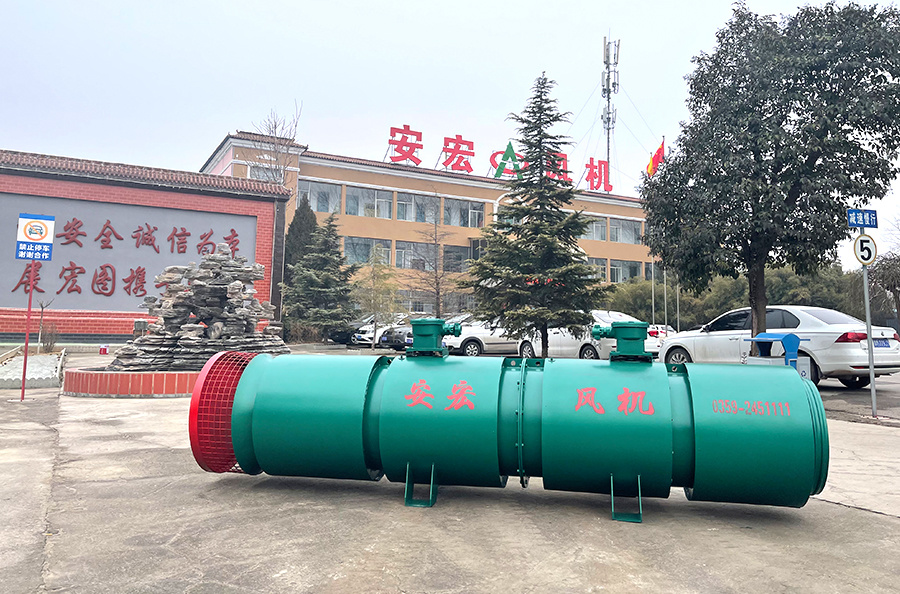
Side air intake local fan
Still deciding? If you are interested, you need to get a sample first,Contact us!
Product Category
FBD series
Tag
Mine ventilation equipment
- Product Description
-
Annular side-inlet low-noise local ventilation fan: Based on the front-rear muffler combination ventilation fan, a side-inlet device has been added. Without affecting the air intake, the airflow direction of the inlet is changed, causing noise refraction. Coupled with inlet and outlet mufflers, the noise is significantly reduced. Tests by the National Mine Equipment Testing and Inspection Center show that the noise is 20-30 decibels lower than that of the front-rear muffler combination local ventilation fan (see Figure 3).

FBD Series Product Introduction
1. Overview
The FBD series explosion-proof, pressure-inlet, contra-rotating axial flow local ventilation fan (hereinafter referred to as the ventilation fan) complies with the standards MT222-2007 "Technical Conditions for Contra-rotating Local Ventilation Fans" and Q/YAF001-2011 "FBD Series Explosion-proof, Pressure-inlet, Contra-rotating Axial Flow Local Ventilation Fans". It is suitable for local ventilation in underground coal mines containing gas, coal dust, or other explosive hazardous environments, and is used with positive pressure ventilation ducts. It can also be used as tunnel construction ventilation equipment. Details are as follows:
(1) The ventilation fan uses computational fluid dynamics for multi-objective overall optimization design. The blades use aviation engine FMIA airfoils, resulting in a large area of high-efficiency operating conditions. The ventilation fan features a compact structure, large air volume, high air pressure, long air delivery distance, high efficiency, energy saving, and low noise.
(2) The ventilation fan is directly driven by two YBF2 series explosion-proof motors for fan use. To extend the service life of the fan, SKF series bearings from Sweden are used for the motor bearings. (Add bearing photo)
(3) According to different user needs, there are 3 types of mufflers to choose from;
a) Ordinary outlet muffler; (Add photo)
b) Inlet and outlet combination muffler; (Add photo)
c) Side-inlet, inlet and outlet combination muffler. (Add photo)
The third type (c) of combination muffler adds a side-inlet component, which changes the airflow direction of the inlet without affecting the air intake, causing noise refraction. Coupled with inlet and outlet mufflers, the noise is significantly reduced. Tests by the National Mine Equipment Testing and Inspection Center show that the noise level is 20-30 decibels lower than that of ordinary ventilation fans.
(4) The explosion-proof type of the ventilation fan and motor is: explosion-proof, and the explosion-proof mark is: ExdbI.
(5) The operating voltage is 380V/660V, 660V/1140V, and does not exceed ±5% of the rated value, and the voltage frequency is 50HZ.
For ventilation fans used underground, the roadway air supply volume should be greater than the maximum operating air volume of the ventilation fan.
The foundation for installing the ventilation fan should be firm and free from dripping water. The height of the edge of the ventilation fan inlet from the ground or top wall should be no less than 0.3m.
The ventilation duct used should be able to withstand the highest pressure of the ventilation fan, and the diameter of the ventilation duct should not be less than the diameter of the impeller.
(6) Service Life
The service life is no less than 5 years, and the safe operating time before the first overhaul is no less than 13000 hours.
2. Structural Features, Working Principle, and Technical Parameters
(1) The ventilation fan consists of a collector, motor, primary fan, secondary fan, motor, muffler, etc. (Figure 1 with ordinary muffler; Figure 2 with inlet and outlet muffler; Figure 3 with side-inlet combination muffler). The ventilation fan shell structural parts are all welded from steel plates, the inner cylinder is welded from perforated steel plates, and lined with sound-absorbing material. The motor is connected to the air duct by bolts using a flange joint. The motor casing and perforated steel plate serve as the inner air duct, and the two impellers rotate contra-rotating at the same speed.
(2) Working Principle
The ventilation fan is driven by two explosion-proof motors of the same capacity and model, with the two impellers rotating in opposite directions. Air enters the primary impeller, obtains energy, and is then discharged through the secondary impeller. The secondary impeller also has the function of the stator vane in an ordinary axial flow fan, straightening the circumferential velocity component while adding energy to the airflow, achieving high efficiency and high air pressure that ordinary axial flow fans cannot achieve.
(3) Technical parameters of the ventilation fan are shown in Figures 1-3
Figure 1 Ventilation fan structural diagram (with ordinary muffler)
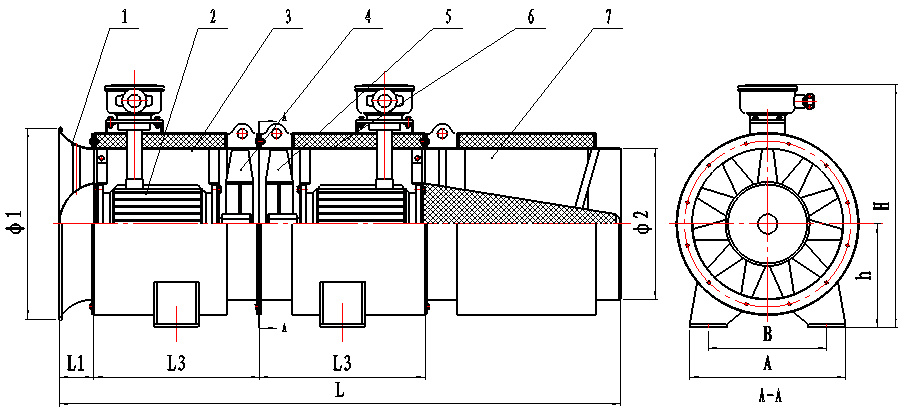
1. Collector, 2. Motor, 3. Primary unit, 4. Primary impeller, 5. Secondary impeller, 6. Secondary unit, 7. Outlet muffler
Machine No.
Motor Model
Power (kW)
Air Volume m³/min
Air Pressure (Pa)
L1
L3
L
Ф1
Ф2
A
B
h
H
Total Weight kg
4.0
YBF₂90L-2
2×2.2
200-110
300-1800
80
500
1680
490
410
400
280
310
740
280
YBF₂112M-2
2×4
220-120
350-2200
5.0
YBF₂132S-2
2×5.5
230-130
400-2750
120
580
1980
620
510
530
420
390
920
400
YBF₂132S-2
2×7.5
280-170
600-3200
6.0
YBF₂160M-2
2×11
380-220
700-3800
130
740
2340
740
610
700
580
410
1000
600
YBF₂160L-2
2×15
430-260
720-4300
6.3
YBF₂160L-2
2×18.5
500-350
750-4800
140
750
2370
780
640
720
600
435
1035
800
YBF₂180ML-2
2×22
550-360
850-5000
7.1
YBF₂200L-2
2×30
630-380
900-5900
150
840
2570
890
730
750
630
495
1145
1000
YBF₂200L-2
2×37
680-400
950-6100
8.0
YBF₂225M-2
2×45
780-440
1050-7500
160
1020
3000
950
820
800
680
530
1250
1450
YBF₂250M-2
2×55
900-540
1100-7800
YBF₂280S-2
2×75
1010-600
1600-8400
Figure 2: Ventilation System Diagram (with inlet and outlet silencers)
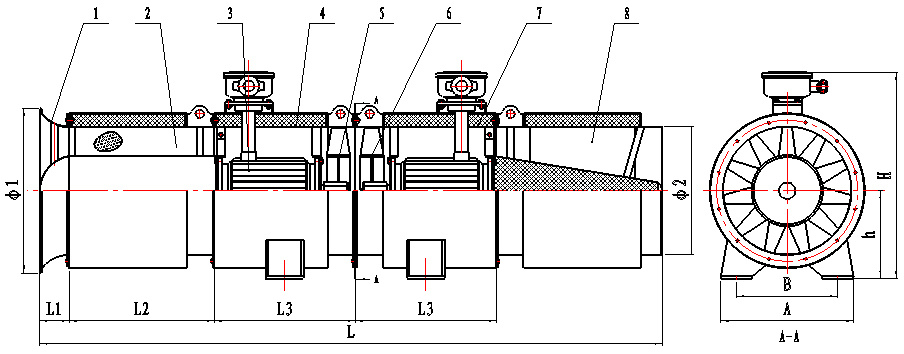
1. Collector, 2. Inlet silencer, 3. Motor, 4. Primary unit, 5. Primary impeller, 6. Secondary impeller, 7. Secondary unit, 8. Outlet silencer
Machine No.
Motor Model
Power kW
Air Volume m³/min
Air pressure Pa
L1
L2
L3
L
Ф1
Ф2
A
B
h
H
Total Weight kg
4.0
YBF₂90L-2
2×2.2
200-110
300-1800
80
600
500
2280
490
410
400
280
310
740
350
YBF₂112M-2
2×4
220-120
350-2200
5.0
YBF₂132S-2
2×5.5
230-130
400-2750
120
700
580
2680
620
510
530
420
390
920
480
YBF₂132S-2
2×7.5
280-170
600-3200
6.0
YBF₂160M-2
2×11
380-220
700-3800
130
730
740
3070
740
610
700
580
410
1000
700
YBF₂160L-2
2×15
430-260
720-4300
6.3
YBF₂160L-2
2×18.5
500-350
750-4800
140
730
750
3100
780
640
720
600
435
1035
920
YBF₂180ML-2
2×22
550-360
850-5000
7.1
YBF₂200L-2
2×30
630-380
900-5900
150
740
840
3310
890
730
750
630
495
1145
1150
YBF₂200L-2
2×37
680-400
950-6100
8.0
YBF₂225M-2
2×45
780-440
1050-7500
160
800
1020
3800
950
820
800
680
530
1250
1600
YBF₂250M-2
2×55
900-540
1100-7800
YBF₂280S-2
2×75
1010-600
1600-8400
Figure 3: Ventilation System Diagram (with side inlet combination silencer)
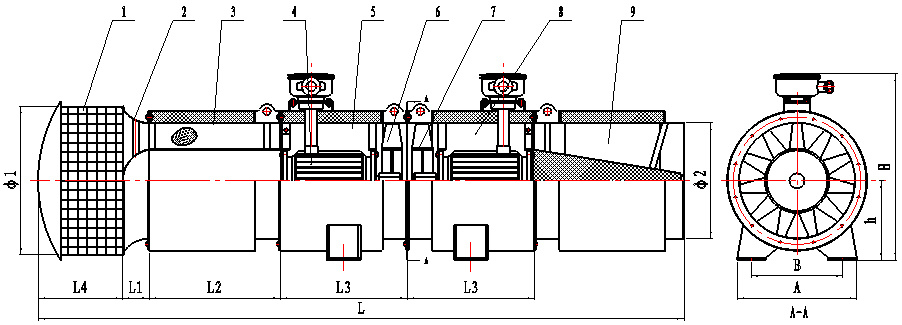
1. Side inlet device, 2. Collector, 3. Inlet silencer, 4. Motor, 5. Primary unit, 6. Primary impeller, 7. Secondary impeller, 8. Secondary unit, 9. Outlet silencer
Machine No.
Motor Model
Power kW
Air Volume m³/min
Air pressure Pa
L1
L2
L3
L
Ф1
Ф2
A
B
h
H
Total Weight kg
4.0
YBF₂90L-2
2×2.2
200-110
300-1800
80
600
500
2580
490
410
400
280
310
740
380
YBF₂112M-2
2×4
220-120
350-2200
5.0
YBF₂132S-2
2×5.5
230-130
400-2750
120
700
580
3010
620
510
530
420
390
920
520
YBF₂132S-2
2×7.5
280-170
600-3200
6.0
YBF₂160M-2
2×11
380-220
700-3800
130
730
740
3420
740
610
700
580
410
1000
750
YBF₂160L-2
2×15
430-260
720-4300
6.3
YBF₂160L-2
2×18.5
500-350
750-4800
140
730
750
3480
780
640
720
600
435
1035
970
YBF₂180ML-2
2×22
550-360
850-5000
7.1
YBF₂200L-2
2×30
630-380
900-5900
150
740
840
3710
890
730
750
630
495
1145
1200
YBF₂200L-2
2×37
680-400
950-6100
8.0
YBF₂225M-2
2×45
780-440
1050-7500
160
800
1020
4250
950
820
800
680
530
1250
1680
YBF₂250M-2
2×55
900-540
1100-7800
YBF₂280S-2
2×75
1010-600
1600-8400
3. Installation and commissioning
(1) Before assembly, the radial clearance between the top of the blade and the inner cylinder of the casing must be checked. The radial clearance should be between 1.5‰ and 3.5‰ of the impeller diameter, and not less than 1 mm; there should be no axial clearance after assembly of each casing.
(2) The impeller rotation direction must conform to the direction indicated by the casing marking.
(3) The ventilation system must be managed and operated by a designated person.
(4) The installation and use of the ventilation system must comply with the relevant provisions of the "Coal Mine Safety Regulations", and the internal and external grounding wires must be securely connected before operation.
(5) The stripped connection of the motor lead-in wire should not exceed 1.5 mm, and the motor should be installed according to the requirements of the motor instruction manual. The six terminals in the motor junction box can be used for two different voltages when changing the connection method (see Figure 2). The phase sequence U, V, W of the motor must correspond to the phase sequence A, B, C of the incoming external power supply. The motor rotation should be clockwise when viewed from the shaft extension end; otherwise, the motor will reverse.

Figure 2: Motor wiring diagram (Note: Motor voltage levels are 380V/660V and 660V/1140V)
4. Use and operation
(1) Preparation and inspection before use
a) The cold-state insulation resistance between the stator winding and the frame of the motor should be measured and must be higher than 50MΩ; if it does not meet the requirements, drying treatment should be carried out.
b) Check for safety marks and explosion-proof certification numbers.
c) All explosion-proof surface parts have no cracks or defects that affect the explosion-proof performance (new motors that have not been disassembled can be omitted).
d) The incoming cable cores must be tightly fixed with wiring plates or U-shaped washers to prevent cable movement.
e) Check whether all fasteners of the ventilation system are complete and firm, whether the connections are reliable, whether the trial operation is flexible, whether there are any abnormal noises or impacts, whether the impeller rotation direction is correct, and whether the grounding wire is connected.
(2) Instructions during use
a) To ensure the long-term safe operation of the ventilation system, attention should be paid to correct use and regular maintenance.
b) When starting, turn on the first-stage ventilation system first, and after running for 5 seconds, turn on the second-stage ventilation system.
c) During operation, frequently check whether the sound is normal and whether there is any loosening at the connections.
d) Motor maintenance should be carried out according to the provisions in the motor instruction manual.
e) The motor bearings should be checked at least once every 6 months of operation. If the bearing grease is found to be deteriorated or leaking, it must be replaced in time. Before replacement, the bearings should be cleaned with gasoline. Use ZL-3 lithium-based grease (Sy142-75), and the amount added should be 1/2 of the net volume of the bearing chamber. (For 180000 series sealed bearings, the grease does not need to be replaced during the service life).
f) The bearing clearance during use should be within the allowable range, the operating temperature of the bearings should not exceed the allowable value, and the sound should be normal. If the bearings are worn or damaged, new bearings should be replaced.
g) If the motor is damp, it must be dried.
h) After a period of use, coal dust may block the silencer holes, so it must be flushed with high-pressure airflow; otherwise, the fan noise will increase.
i) Check the fan once a month, checking all parts of the machine.
j) When the fan is not in use, it should be placed in a well-ventilated and dry place to prevent dampness, corrosion, and other damage.
5. Fault Analysis and Troubleshooting
Table 1 Main Faults and Troubleshooting Methods
Fault Characteristics
Cause of Failure
Fault Identification and Troubleshooting
Metallic collision sound inside the fan
Blade rubbing against the casing
Replace the blade or casing
Metal objects entering
Remove foreign objects
Motor bearing damage
Replace the motor or bearing
Bearing has a whistling sound (accompanied by temperature increase)
Too much, too little, or unclean lubricating grease
Reduce or add lubricating grease or clean the bearing
Lubricating grease aging or incorrect type
Replace the lubricating grease
Bearing vibration and internal collision sound
Too much lubricating oil or bearing fatigue wear
Reduce lubricating grease or replace bearing
Fan and motor vibration
Impeller dynamic balance destroyed
Replace the impeller
Insufficient foundation hardness and damage
Check the foundation
Flange connection bolts loose
Check all connecting bolts
Insufficient pressure or air volume
Air duct leakage or insufficient motor speed
Check for leaks or check the motor
Increased vibration, intermittent noise
The fan is operating under unstable conditions
Check the fan intake and exhaust conditions
Fan one or two stages stop running
Motor damage or power failure
Replace the motor or reconnect the power
Buzzing sound when power is turned on
Incorrect phase sequence of the motor
Swap any two of the power supply lines
Fan is difficult to start
Power voltage too low or starter malfunction
Increase the power voltage or check the starter
6. Matters needing attention when using the fan
When using the fan in underground coal mines, the relevant regulations in the "Coal Mine Safety Regulations" must be strictly observed:
(1) The mining face using the fan must not stop ventilation. When ventilation is stopped due to maintenance power failure, personnel must be evacuated and the power must be cut off.
(2) Before resuming ventilation, methane must be checked. Only when the methane concentration in the airflow within 10 meters of the fan and its switch does not exceed 0.5% can the local ventilation fan be manually started.
(3) If the fan stops running due to a fault, before resuming ventilation, methane must be checked first. Only when the highest methane concentration in the ventilation-stopped area does not exceed 1.0% and the highest carbon dioxide concentration does not exceed 1.5%, and the conditions in point 2 are met, can the fan be manually started to resume normal ventilation.
(4) When using a counter-rotating axial flow fan, both sets of impellers must be started simultaneously. If one motor is damaged, the entire machine must be stopped for maintenance, and single-stage start-up is not allowed.
Side air intake local fan
Still deciding? If you are interested, you need to get a sample first,Contact us!
Product Category
Tag
Mine ventilation equipment
Get a Quote
* Note: Please be sure to fill in the information accurately and keep the communication open. We will contact you as soon as possible.
Related Products





